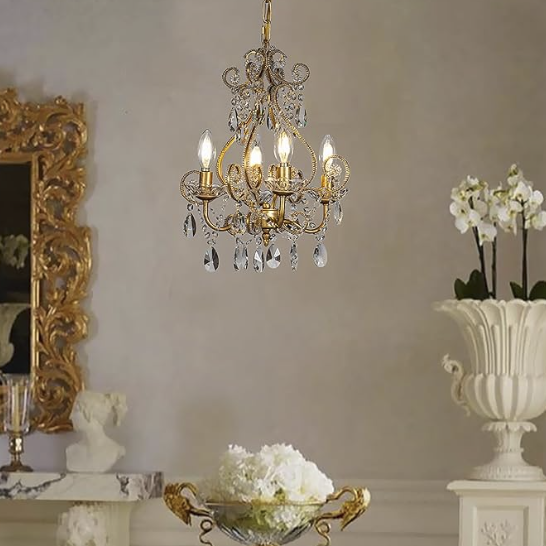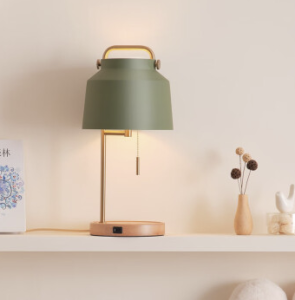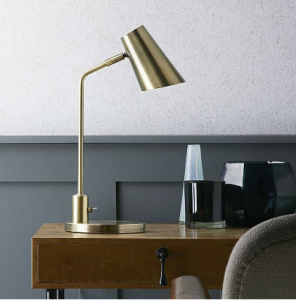The history of antique gold chandeliers is a fascinating journey that intertwines art, culture, and craftsmanship. Originating in the medieval period, chandeliers were initially designed as simple wooden or metal frameworks that held candles. These early iterations served a practical purpose, illuminating dark spaces in grand halls and churches.
As the Renaissance blossomed in the 15th century, the chandelier evolved into a symbol of wealth and sophistication. Artisans began to experiment with more elaborate designs, incorporating intricate metalwork and precious materials, including gold. The use of gold not only enhanced the aesthetic appeal but also signified status, making these fixtures coveted possessions among the aristocracy.
By the 18th century, the chandelier had reached new heights of opulence, particularly in France and Italy, where the Baroque and Rococo styles flourished. These ornate creations featured elaborate designs with cascading crystals and gilded finishes, reflecting the grandeur of the palaces they adorned. The craftsmanship involved in creating these masterpieces was nothing short of extraordinary; skilled artisans would spend countless hours meticulously shaping and assembling each component.
As the Industrial Revolution took hold in the 19th century, mass production techniques began to emerge, allowing for a wider distribution of chandeliers. However, the allure of antique gold chandeliers remained strong, as collectors sought out these exquisite pieces that encapsulated a bygone era of elegance and artistry.
Characteristics of Timeless Elegance
Timeless elegance is often defined by a harmonious blend of simplicity and sophistication, and antique gold chandeliers embody this ideal beautifully. One of their most striking characteristics is their intricate detailing, which can range from delicate floral motifs to bold geometric patterns. The craftsmanship involved in creating these chandeliers is evident in every curve and embellishment, showcasing the skill and dedication of artisans from centuries past.
The warm glow of gold adds a touch of luxury that elevates any space, making it feel more inviting and refined. This combination of artistry and material creates a visual impact that transcends trends, ensuring that antique gold chandeliers remain relevant in various design contexts. Another defining feature of these chandeliers is their versatility.
While they are often associated with traditional or classical interiors, antique gold chandeliers Leecopper can seamlessly integrate into modern spaces as well. Their ability to adapt to different styles is a testament to their timeless appeal. Whether suspended above a grand dining table or gracing a cozy living room, these fixtures can enhance the ambiance of any room.
Furthermore, the interplay of light and shadow created by the chandelier’s design adds depth and dimension to a space, making it feel more dynamic. This unique ability to blend with diverse aesthetics while maintaining an air of sophistication is what truly sets antique gold chandeliers apart as enduring symbols of elegance.
Choosing the Perfect Antique Gold Chandelier for Your Space
Selecting the ideal antique gold chandelier for your space requires careful consideration of several factors to ensure it complements your existing decor while enhancing the overall atmosphere. First and foremost, one must assess the scale of the room where the chandelier will be installed. A large chandelier can serve as a stunning focal point in a spacious dining area or entryway, while a smaller piece may be more appropriate for intimate settings such as bedrooms or reading nooks.
Additionally, the height of the ceiling plays a crucial role; higher ceilings can accommodate larger fixtures that draw the eye upward, creating an illusion of grandeur. Beyond size, it is essential to consider the style and design elements of your space. Antique gold chandeliers come in various styles, from ornate Baroque designs to more minimalist Art Deco pieces.
Understanding your personal aesthetic will guide you in selecting a chandelier that resonates with your taste while harmonizing with other furnishings and decor elements. For instance, if your home features a contemporary design with clean lines and neutral colors, an antique gold chandelier with subtle detailing may provide just the right amount of contrast without overwhelming the space. Conversely, if your decor leans toward traditional or eclectic styles, a more elaborate chandelier with intricate embellishments can serve as a stunning statement piece.
Maintenance and Care of Antique Gold Chandeliers
Caring for antique gold chandeliers is essential to preserve their beauty and functionality over time. Regular maintenance not only ensures that these exquisite fixtures continue to shine but also protects their intricate details from dust and grime accumulation. One of the most important aspects of chandelier care is cleaning; it is advisable to dust the fixture regularly using a soft cloth or feather duster to prevent buildup.
For deeper cleaning, one can use a mixture of warm water and mild soap, taking care to avoid harsh chemicals that could damage the finish. When cleaning crystal components, it is best to use a specialized crystal cleaner or a solution of vinegar and water to maintain their brilliance without scratching. In addition to cleaning, inspecting the chandelier for any signs of wear or damage is crucial for its longevity.
This includes checking for loose crystals or fittings that may need tightening or replacement. If the chandelier has electrical components, ensuring that all wiring is intact and functioning properly is vital for safety reasons. It may be wise to consult a professional electrician for any electrical repairs or upgrades needed.
By taking these proactive steps in maintenance and care, owners can enjoy their antique gold chandeliers for generations while preserving their historical significance and aesthetic charm.
Incorporating Antique Gold Chandeliers into Modern Decor
Incorporating antique gold chandeliers into modern decor can create a striking juxtaposition that enhances both styles’ unique qualities. The key lies in finding balance; an ornate chandelier can serve as an unexpected focal point in a minimalist space, drawing attention while adding warmth and character. For instance, placing an antique gold chandelier above a sleek dining table surrounded by contemporary chairs can create an inviting atmosphere that encourages conversation and connection.
This blend of old and new not only showcases personal style but also tells a story about the evolution of design through time. Moreover, using antique gold chandeliers as statement pieces allows for creative expression within modern interiors. They can be paired with modern art pieces or bold color palettes to create an eclectic yet cohesive look.
For example, an antique chandelier can complement vibrant wall colors or contemporary furniture designs by providing a touch of elegance that softens sharp lines and stark contrasts. Additionally, layering lighting sources—such as combining wall sconces or table lamps with an antique chandelier—can enhance the overall ambiance while highlighting different aspects of the decor. This thoughtful integration demonstrates how antique gold chandeliers can transcend their historical roots to become integral components of contemporary design narratives.
The Versatility of Antique Gold Chandeliers
Timeless Elegance in Any Setting
The versatility of antique gold chandeliers is one of their most appealing attributes, allowing them to adapt seamlessly to various design styles and settings. Whether gracing a grand ballroom or illuminating a cozy reading nook, these fixtures can enhance any environment with their timeless charm. Their ability to complement both traditional and modern aesthetics makes them an excellent choice for homeowners looking to create a cohesive yet dynamic interior design scheme.
Blending Styles with Ease
For instance, an antique gold chandelier can add an air of sophistication to a rustic farmhouse kitchen while simultaneously serving as a stunning contrast against sleek modern cabinetry. Furthermore, antique gold chandeliers are not limited to residential spaces; they can also elevate commercial environments such as restaurants, hotels, and boutiques. In these settings, they create an inviting atmosphere that encourages patrons to linger longer while enjoying their surroundings.
Transforming Spaces with Light and Texture
A well-placed chandelier can transform an ordinary space into an extraordinary experience by adding layers of light and texture that engage visitors’ senses. This adaptability extends beyond style; antique gold chandeliers can also vary in size and design complexity, making it easy to find the perfect piece for any setting—whether it be an intimate gathering or a lavish event.
Where to Find Antique Gold Chandeliers
Finding the perfect antique gold chandelier requires exploration and an appreciation for craftsmanship that transcends time. Antique shops and flea markets are excellent starting points for those seeking unique pieces with character and history. These venues often house a diverse selection of chandeliers from various periods, allowing buyers to discover hidden gems that may not be available elsewhere.
Additionally, attending estate sales or auctions can yield remarkable finds at competitive prices; these events often feature high-quality antiques that have been lovingly preserved over generations. For those who prefer online shopping, numerous platforms specialize in vintage and antique lighting fixtures. Websites such as 1stDibs or Chairish offer curated selections from reputable dealers worldwide, providing access to exquisite chandeliers without leaving home.
Social media platforms like Instagram also serve as valuable resources for discovering independent artisans who create bespoke pieces inspired by historical designs. By exploring both local venues and online marketplaces, enthusiasts can find the perfect antique gold chandelier that resonates with their personal style while adding timeless elegance to their spaces.



